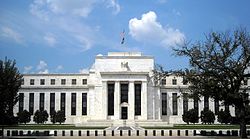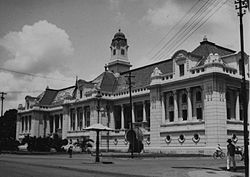Central bank
A central bank (or reserve bank) manages a state's currency, money supply, and interest rates. It may have custody of the country's sovereign wealth fund.
Central banks usually oversee the commercial banks of their country. It issues the national currency, the nation's money.[1] It controls the overall supply of money and monetary policy. In contrast to a commercial bank, a central bank can increase or decrease the amount of money in the nation.
The oldest central bank is the Bank of England. The largest banks are now the European Central Bank (ECB) and the Federal Reserve of the United States.[2]
Central banks usually also have supervisory powers. These powers are meant to prevent bank runs, and to stop commercial banks and other financial institutions doing reckless or fraudulent things. The relation between central banks and governments varies from country to country.
The chief executive of a central bank is normally known as the Governor, President or Chairman.
Central Bank Media
Walter Bagehot, influential 19th-century theorist of the economic role of central banks
Interior of the Llotja de Barcelona where the city's Taula de canvi was operated
The Bank of England in 1791
The Bank of Finland in Helsinki
The Eccles Building in Washington, D.C. houses the main offices of the Board of Governors of the Federal Reserve.
Head office of the People's Bank of China in Beijing
The European Central Bank's main building in Frankfurt
Octavian Armașu, NBM gorvernor, whose dismissal in 2023 raised concerns about central bank independence in Moldova
References
- ↑ Sullivan, Arthur; Steven M. Sheffrin (2003). Economics: Principles in action. Prentice Hall. p. 254. ISBN 0-13-063085-3. Archived from the original on 2021-03-04. Retrieved 2021-02-26.
- ↑ "The structure of the Federal Reserve System". federalreserveeducation.org. Archived from the original on 3 October 2010. Retrieved 1 October 2010.








